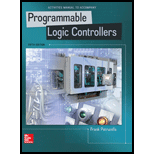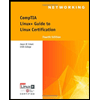
Activities Manual for Programmable Logic Controllers
5th Edition
ISBN: 9781259679568
Author: Petruzella, Frank
Publisher: MCGRAW-HILL HIGHER EDUCATION
expand_more
expand_more
format_list_bulleted
Question
Chapter 3, Problem 1P
Program Plan Intro
Programmable Logic Controller (PLC):
- PLC is a specialized computer used in industrial segments to control machines and process.
- PLC is program that consists of a set of instructions which resembles the controlling functions needed to perform specific tasks.
- The function of PLC is similar to that of a relay and hence, in an industrial segment a relay is greatly replaced by a suitable PLC.
- When compared to general Personal Computer (PC), a PLC is available in small and tiny sizes.
- The basic architecture of a PLC consists of an input-output interface module and a small Central Processing Unit (CPU) that runs by controlling
programming language.
Hexadecimal number system:
- In hexadecimal number system, the numbers from “0” to “9” and letters from “A” to “F” are used.
- It means, in total, hexadecimal system has 10 numbers and 6 alphabets.
- Therefore, the base used for hexadecimal numbering system is 16.
Binary number system:
- In binary system, the numbers “0” and “1” are only used.
- It means, in total, binary system has only 2 numbers.
- Therefore, the base used for binary numbering system is 2.
Explanation of Solution
b.
Conversion of binary number to its equivalent hexadecimal code:
- Given, binary number is “00100101”.
- First, the given binary number is partitioned into two groups, such that each group contains only four bits.
- Now, each group is converted to its corresponding hexadecimal code.
- Here, “0010” is one such group and “0101” is the other group.
- The following diagram describes the hexadecimal notation of the binary number “0010”.
- The hexadecimal equivalent of decimal number “2” is “2”...
Explanation of Solution
c.
Conversion of binary number to its equivalent hexadecimal code:
- Given, binary number is “01001110”.
- First, the given binary number is partitioned into two groups, such that each group contains only four bits.
- Now, each group is converted to its corresponding hexadecimal code.
- Here, “0100” is one such group and “1110” is the other group.
- The following diagram describes the hexadecimal notation of the binary number “0100”.
- The hexadecimal equivalent of decimal number “4” is “4”...
Explanation of Solution
d.
Conversion of binary number to its equivalent hexadecimal code:
- Given, binary number is “00111001”.
- First, the given binary number is partitioned into two groups, such that each group contains only four bits.
- Now, each group is converted to its corresponding hexadecimal code.
- Here, “0011” is one such group and “1001” is the other group.
- The following diagram describes the hexadecimal notation of the binary number “0011”.
- The hexadecimal equivalent of decimal number “3” is “3”...
Expert Solution & Answer
Want to see the full answer?
Check out a sample textbook solution
Students have asked these similar questions
Show all the work
Show all the work
[5 marks] Give a recursive definition for the language anb2n where n = 1, 2, 3, ... over the alphabet Ó={a, b}.
2) [12 marks] Consider the following languages over the alphabet ={a ,b},
(i) The language of all words that begin and end an a
(ii) The language where every a in a word is immediately followed by at least one b.
(a) Express each as a Regular Expression
(b) Draw an FA for each language
(c) For Language (i), draw a TG using at most 3 states
(d) For Language (ii), construct a CFG.
Chapter 3 Solutions
Activities Manual for Programmable Logic Controllers
Ch. 3 - Prob. 1RQCh. 3 - Convert each of the following decimal numbers to...Ch. 3 - Prob. 3RQCh. 3 - Prob. 4RQCh. 3 - Prob. 5RQCh. 3 - Prob. 6RQCh. 3 - Prob. 7RQCh. 3 - Prob. 8RQCh. 3 - Prob. 9RQCh. 3 - Prob. 10RQ
Ch. 3 - Prob. 11RQCh. 3 - Define the term sign bit.Ch. 3 - Prob. 13RQCh. 3 - Prob. 14RQCh. 3 - Prob. 15RQCh. 3 - Prob. 16RQCh. 3 - Prob. 17RQCh. 3 - Prob. 18RQCh. 3 - Prob. 19RQCh. 3 - Prob. 1PCh. 3 - Prob. 2PCh. 3 - Prob. 3PCh. 3 - Prob. 4PCh. 3 - Prob. 5PCh. 3 - Prob. 6PCh. 3 - Prob. 7PCh. 3 - Prob. 8PCh. 3 - Prob. 9PCh. 3 - Prob. 10P
Knowledge Booster
Similar questions
- Question 1 Generate a random sample of standard lognormal data (rlnorm()) for sample size n = 100. Construct histogram estimates of density for this sample using Sturges’ Rule, Scott’s Normal Reference Rule, and the FD Rule. Question 2 Construct a frequency polygon density estimate for the sample in Question 1, using bin width determined by Sturges’ Rule.arrow_forwardGenerate a random sample of standard lognormal data (rlnorm()) for sample size n = 100. Construct histogram estimates of density for this sample using Sturges’ Rule, Scott’s Normal Reference Rule, and the FD Rule.arrow_forwardCan I get help with this case please, thank youarrow_forward
- I need help to solve the following, thank youarrow_forwardreminder it an exercice not a grading work GETTING STARTED Open the file SC_EX19_EOM2-1_FirstLastNamexlsx, available for download from the SAM website. Save the file as SC_EX19_EOM2-1_FirstLastNamexlsx by changing the “1” to a “2”. If you do not see the .xlsx file extension in the Save As dialog box, do not type it. The program will add the file extension for you automatically. With the file SC_EX19_EOM2-1_FirstLastNamexlsx still open, ensure that your first and last name is displayed in cell B6 of the Documentation sheet. If cell B6 does not display your name, delete the file and download a new copy from the SAM website. Brad Kauffman is the senior director of projects for Rivera Engineering in Miami, Florida. The company performs engineering projects for public utilities and energy companies. Brad has started to create an Excel workbook to track estimated and actual hours and billing amounts for each project. He asks you to format the workbook to make the…arrow_forwardNeed help completing this algorithm here in coding! 2arrow_forward
arrow_back_ios
SEE MORE QUESTIONS
arrow_forward_ios
Recommended textbooks for you
 Enhanced Discovering Computers 2017 (Shelly Cashm...Computer ScienceISBN:9781305657458Author:Misty E. Vermaat, Susan L. Sebok, Steven M. Freund, Mark Frydenberg, Jennifer T. CampbellPublisher:Cengage Learning
Enhanced Discovering Computers 2017 (Shelly Cashm...Computer ScienceISBN:9781305657458Author:Misty E. Vermaat, Susan L. Sebok, Steven M. Freund, Mark Frydenberg, Jennifer T. CampbellPublisher:Cengage Learning CompTIA Linux+ Guide to Linux Certification (Mind...Computer ScienceISBN:9781305107168Author:Jason EckertPublisher:Cengage Learning
CompTIA Linux+ Guide to Linux Certification (Mind...Computer ScienceISBN:9781305107168Author:Jason EckertPublisher:Cengage Learning Systems ArchitectureComputer ScienceISBN:9781305080195Author:Stephen D. BurdPublisher:Cengage Learning
Systems ArchitectureComputer ScienceISBN:9781305080195Author:Stephen D. BurdPublisher:Cengage Learning A+ Guide to Hardware (Standalone Book) (MindTap C...Computer ScienceISBN:9781305266452Author:Jean AndrewsPublisher:Cengage Learning
A+ Guide to Hardware (Standalone Book) (MindTap C...Computer ScienceISBN:9781305266452Author:Jean AndrewsPublisher:Cengage Learning A+ Guide To It Technical SupportComputer ScienceISBN:9780357108291Author:ANDREWS, Jean.Publisher:Cengage,
A+ Guide To It Technical SupportComputer ScienceISBN:9780357108291Author:ANDREWS, Jean.Publisher:Cengage,

Enhanced Discovering Computers 2017 (Shelly Cashm...
Computer Science
ISBN:9781305657458
Author:Misty E. Vermaat, Susan L. Sebok, Steven M. Freund, Mark Frydenberg, Jennifer T. Campbell
Publisher:Cengage Learning

CompTIA Linux+ Guide to Linux Certification (Mind...
Computer Science
ISBN:9781305107168
Author:Jason Eckert
Publisher:Cengage Learning


Systems Architecture
Computer Science
ISBN:9781305080195
Author:Stephen D. Burd
Publisher:Cengage Learning

A+ Guide to Hardware (Standalone Book) (MindTap C...
Computer Science
ISBN:9781305266452
Author:Jean Andrews
Publisher:Cengage Learning

A+ Guide To It Technical Support
Computer Science
ISBN:9780357108291
Author:ANDREWS, Jean.
Publisher:Cengage,